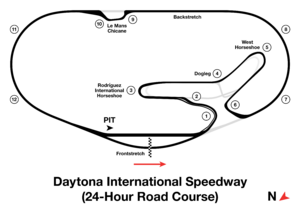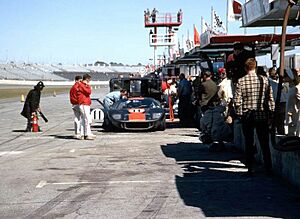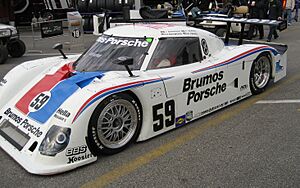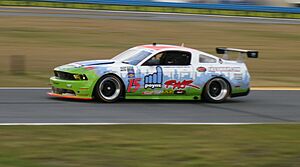24 Hours of Daytona facts for kids
 |
|
 |
|
| IMSA WeatherTech SportsCar Championship | |
|---|---|
| Venue | Daytona International Speedway |
| Corporate sponsor | Rolex |
| First race | 1962 |
| Last race | 2025 |
| Duration | 24 hours |
| Previous names | Daytona 3 Hour Continental (1962–1963) Daytona 2000 (1964–1965) 24 Hours of Daytona (1966–1971, 1973, 1975–1977) 6 Hours of Daytona (1972) 24 Hour Pepsi Challenge (1978–1983) SunBank 24 at Daytona (1984–1991) Rolex 24 At Daytona (1992–Present) |
| Most wins (driver) | Hurley Haywood (5) Scott Pruett (5) |
| Most wins (team) | Chip Ganassi Racing (6) |
| Most wins (manufacturer) | Porsche (20) |
The 24 Hours of Daytona is a super exciting 24-hour sports car race. It's also called the Rolex 24 At Daytona because of its main sponsor. This long race happens every year at the Daytona International Speedway in Daytona Beach, Florida.
Drivers race on a special track called the Sports Car Course. It's a mix of the big oval track and a twisty inside section, about 3.56 miles (5.73 km) long. This race is usually held in late January or early February. It's the very first big car race of the year in North America. The race is part of the IMSA SportsCar Championship season.
The race has had different sponsor names over the years. Since 1992, Rolex has been the main sponsor. Before that, it was sponsored by Sunbank and Pepsi. Winning drivers in all categories get a special Rolex Daytona watch. This race is also famous as one of the "Triple Crown of endurance racing." The other two are the 24 Hours of Le Mans and the 12 Hours of Sebring.
Contents
How the Race Started
The first big sports car race at Daytona was in 1959. It was a six-hour race, not 24 hours. Count Antonio Von Dory and Roberto Mieres won it in a Porsche. This early race was shorter because it got dark.
In 1962, a three-hour sports car race began. It was called the Daytona Continental. This race was part of a big international championship. Dan Gurney won the first Continental race. He drove a Lotus 19 car.
In the past, a car had to cross the finish line after 24 hours to be counted. This led to exciting moments. Damaged cars would wait near the finish line for hours. Then, they would restart their engines and slowly cross the line. This way, they could finish the race. For example, in 1962, Dan Gurney's car broke down near the end. He let gravity pull his car across the line to win! This led to a new rule: cars must cross the line using their own power.
In 1964, the race became longer, covering 2000 kilometers (about 1243 miles). This was twice as long as other famous races. Then, in 1966, the Daytona race became a full 24-hour event, just like the famous Le Mans race.
Exciting 24-Hour Races
The first 24-hour race in 1966 was won by Ken Miles and Lloyd Ruby. They drove a Ford Mk. II. That same year, Suzy Dietrich and her team became the first women's team to finish a 24-hour international race.
In 1967, after losing to Ford in other races, Ferrari P cars made a big comeback. They finished first, second, and third, driving side-by-side across the finish line. Because of this win, a Ferrari 365 GTB/4 road car was later nicknamed "Ferrari Daytona."
Porsche did something similar in 1968. They also finished 1-2-3. Their drivers helped each other's cars to make sure they all finished well. This showed great teamwork!
In 1969, Lola cars finished first and second. The winning car was driven by Mark Donohue and Chuck Parsons. Not many people were there to see it, though.
From 1971 onwards, races started with "rolling starts." This means cars drive slowly in a line before the race officially begins. Before that, drivers had to run to their cars at the start.
In 1972, the race was shortened to six hours because of new rules. In 1974, it was canceled completely due to an energy crisis. The International Motor Sports Association (IMSA) took over the race in 1975.
A big crash happened in 2014 involving Memo Gidley and Matteo Malucelli. Both drivers survived, and the race was stopped for a while.
Today, race teams usually have four drivers. This is because the race is so long, especially with night driving. In the top classes, all four drivers are usually professionals. In other classes, some drivers are "amateur drivers." These are people who have other jobs but love racing. Often, a famous professional driver joins a team just for Daytona. Some famous names include Scott Dixon, Jeff Gordon, Fernando Alonso, and Kyle Busch.
Unlike the Le Mans race, the Daytona race happens entirely inside the speedway. It doesn't use any public roads. The track has bright lights for night racing, but the inside section is not as bright as the main oval.
GTP Cars: The Fastest Racers
In the 1990s, the Daytona race became part of the Grand-Am series. This series was linked to NASCAR. It focused on keeping costs down and making races exciting.
New rules in 2002 made sports car racing less expensive. Special cars called Daytona Prototypes (DP) were introduced. They used simpler materials and designs. This helped teams save money on building and testing cars. These DPs started racing in 2003.
Companies like Riley, Dallara, and Lola build the DP cars. Big car companies like Cadillac, Lexus, Ford, BMW, and Porsche provide the engines.
In 2017, new DPi prototypes were introduced. These cars were based on other race car designs but had custom engines and bodywork from major car makers.
For the 2023 race, the top class of cars was called LMDh prototypes. Other fast cars called Le Mans Hypercars were also allowed. The series also brought back the old name "Grand Touring Prototype" (GTP) from the 1980s.
GT Daytona Cars: Close to Road Cars
The Gran Turismo (GT) class cars at Daytona are very similar to cars you see on the road. They are like the GT3 class cars used in other races. For example, a more standard version of the Porsche 996 is used.
Recent GT cars in the race have included BMW M3s and M6s, Porsche 911s, Chevy Camaros, Corvettes, Mazda RX-8s, and Ferrari F430 Challenges. The Audi R8 and Ferrari 458 Italia first raced in 2012.
Since 2014, the GT Daytona class has used only Group GT3 cars. There was also a GTLM class for LM GTE cars. In 2022, the GTLM class was replaced by GTD Pro. Both GTD classes use the same cars, but GTD requires one amateur driver. GTD PRO allows any driver.
GX Class: A Unique Year
The 2013 race was the only year for the GX class. Six cars raced in this category. It included specially built Porsche Cayman S and Mazda 6 racecars. Mazda even raced its first diesel racecar that year.
During the race, the Porsche Caymans were very strong. All three Mazda cars had engine problems and had to stop. The #16 Napleton Porsche Cayman won the GX class by a large lead.
Race Statistics
Drivers with Multiple Wins
| Rank | Driver | Wins | Years |
|---|---|---|---|
| 1 | 5 | 1973, 1975, 1977, 1979, 1991 | |
| 1994, 2007, 2008, 2011, 2013 | |||
| 3 | 4 | 1963, 1964, 1970, 1971 | |
| 1983, 1985, 1989, 1991 | |||
| 1973, 1975, 1976, 1978 | |||
| 1968, 1978, 1980, 1982 | |||
| 7 | 3 | 1970, 1976, 1981 | |
| 1990, 1997, 1999 | |||
| 1994, 1997, 1999 | |||
| 1986, 1987, 1989 | |||
| 2007, 2008, 2013 | |||
| 2008, 2011, 2013 | |||
| 2004, 2014, 2018 | |||
| 2010, 2014, 2018 | |||
| 2006, 2015, 2020 | |||
| 2021, 2022, 2023 | |||
| 17 | 2 | 1965, 1966 | |
| 1965, 1966 | |||
| 1983, 1985 | |||
| 1986, 1987 | |||
| 1986, 1987 | |||
| 1988, 1990 | |||
| 1982, 1997 | |||
| 1997, 1999 | |||
| 1998, 2002 | |||
| 1998, 2002 | |||
| 1996, 2005 | |||
| 2004, 2010 | |||
| 1996, 2016 | |||
| 2005, 2017 | |||
| 2017, 2019 | |||
| 2019, 2020 | |||
| 2019, 2020 | |||
| 2017, 2021 | |||
| 2018, 2021 | |||
| 2022, 2023 | |||
| 2022, 2023 | |||
| 2024, 2025 |
Wins by Car Manufacturer
Porsche has won the most overall victories, with 23 wins! These wins came from different Porsche models. Porsche also won 11 races in a row from 1977 to 1987. They won 18 out of 23 races between 1968 and 1991. Porsche also won the 2024 and 2025 races.
| Rank | Manufacturer | Wins | Years |
|---|---|---|---|
| 1 | 20 | 1968, 1970, 1971, 1973, 1975, 1977, 1978, 1979, 1980, 1981, 1982, 1983, 1985, 1986, 1987, 1989, 1991, 2003, 2024, 2025 |
|
| 2 | 10 | 2005, 2006, 2007, 2008, 2009, 2010, 2011, 2012, 2013, 2015 | |
| 3 | 5 | 1963, 1964, 1967, 1972, 1998 | |
| 4 | 4 | 2017, 2018, 2019, 2020 | |
| 5 | 3 | 1996, 1997, 1999 | |
| 2021, 2022, 2023 | |||
| 6 | 2 | 1965, 1966 | |
| 1988, 1990 | |||
| 1992, 1994 | |||
| 10 | 1 | 1962 | |
| 1969 | |||
| 1976 | |||
| 1984 | |||
| 1993 | |||
| 1995 | |||
| 2000 | |||
| 2001 | |||
| 2002 | |||
| 2004 | |||
| 2014 | |||
| 2016 |
Wins by Engine Manufacturer
Porsche has 24 wins as an engine maker. This includes wins where they also made the car, and wins where their engines were used in other car brands. General Motors has 10 wins with its different brands like Oldsmobile, Pontiac, Chevrolet, and Cadillac.
| Rank | Engine manufacturer | Wins | Years |
|---|---|---|---|
| 1 | 24 | 1968, 1970, 1971, 1973, 1975, 1977, 1978, 1979, 1980, 1981, 1982, 1983, 1984, 1985, 1986, 1987, 1989, 1991, 1995, 2003, 2009, 2010, 2024, 2025 |
|
| 2 | 6 | 1965, 1966, 1997, 1999, 2012, 2015 | |
| 3 | 5 | 1963, 1964, 1967, 1972, 1998 | |
| 4 | 4 | 2017, 2018, 2019, 2020 | |
| 5 | 3 | 1976, 2011, 2013 | |
| 1969, 2001, 2014 | |||
| 2006, 2007, 2008 | |||
| 2021, 2022, 2023 | |||
| 8 | 2 | 1988, 1990 | |
| 1992, 1994 | |||
| 2004, 2005 | |||
| 12 | 1 | 1962 | |
| 1993 | |||
| 1996 | |||
| 2000 | |||
| 2002 | |||
| 2016 |
Overall Winners
| Year | Date | Drivers | Team | Car | Tire | Car # | Distance | Laps | Championship |
|---|---|---|---|---|---|---|---|---|---|
| 3-hour duration | |||||||||
| 1962 | February 11 | Lotus 19B-Coventry Climax | G | 96 | 312.4 mi (502.8 km) | 82 | International Championship for GT Manufacturers | ||
| 1963 | February 17 | Ferrari 250 GTO | G | 18 | 307.3 mi (494.6 km) | 81 | International Championship for GT Manufacturers | ||
| 2000 km distance | |||||||||
| 1964 | February 16 | Ferrari 250 GTO | G | 30 | 1,243 mi (2,000 km) | 315 | International Championship for GT Manufacturers | ||
| 1965 | February 28 | Ford GT | G | 73 | 1,243 mi (2,000 km) | 315 | International Championship for GT Manufacturers | ||
| 24-hour duration | |||||||||
| 1966 | February 5 February 6 |
Ford GT40 Mk. II | G | 98 | 2,583.2 mi (4,157.2 km) | 678 | International Championship for Sports-Prototypes International Championship for Sports Cars |
||
| 1967 | February 4 February 5 |
Ferrari 330 P4 | F | 23 | 2,537.5 mi (4,083.6 km) | 666 | International Championship for Sports-Prototypes International Championship for Sports Cars |
||
| 1968 | February 3 February 4 |
Porsche 907LH | D | 54 | 2,564.1 mi (4,126.6 km) | 673 | International Championship for Makes | ||
| 1969 | February 1 February 2 |
Lola T70 Mk.3B-Chevrolet | G | 6 | 2,385.0 mi (3,838.4 km) | 626 | International Championship for Makes | ||
| 1970 | January 31 February 1 |
Porsche 917K | F | 2 | 2,758.4 mi (4,439.3 km) | 724 | International Championship for Makes | ||
| 1971 | January 30 January 31 |
Porsche 917K | F | 2 | 2,621.3 mi (4,218.5 km) | 688 | International Championship for Makes | ||
| 6-hour duration | |||||||||
| 1972 | February 6 | Ferrari 312 PB | F | 2 | 739.1 mi (1,189.5 km) | 194 | World Championship for Makes | ||
| 24-hour duration | |||||||||
| 1973 | February 2 February 3 |
Porsche Carrera RSR | G | 59 | 2,552.7 mi (4,108.2 km) | 670 | World Championship for Makes | ||
| 1974 | No race due to energy crisis | ||||||||
| 1975 | February 1 February 2 |
Porsche Carrera RSR | G | 59 | 2,606.1 mi (4,194.0 km) | 679 | World Championship for Makes IMSA GT Championship |
||
| 1976 | January 31 February 1 |
BMW 3.0 CSL | G | 59 | 2,092.8 mi (3,368.0 km) | 545 | IMSA GT Championship | ||
| 1977 | February 5 February 6 |
Porsche Carrera RSR | G | 43 | 2,615.0 mi (4,208.5 km) | 681 | World Championship for Makes IMSA GT Championship |
||
| 1978 | February 4 February 5 |
Porsche 935/77 | G | 99 | 2,611.2 mi (4,202.3 km) | 680 | World Championship for Makes IMSA GT Championship |
||
| 1979 | February 3 February 4 |
Porsche 935/79 | G | 0 | 2,626.5 mi (4,227.0 km) | 684 | World Championship for Makes IMSA GT Championship |
||
| 1980 | February 2 February 3 |
Porsche 935J | D | 2 | 2,745.6 mi (4,418.6 km) | 715 | World Championship for Makes IMSA GT Championship |
||
| 1981 | January 31 February 1 |
Porsche 935 K3 | G | 9 | 2,718.7 mi (4,375.4 km) | 708 | World Endurance Championship IMSA GT Championship |
||
| 1982 | January 30 January 31 |
Porsche 935 JLP-3 | G | 18 | 2,761.0 mi (4,443.3 km) | 719 | IMSA GT Championship | ||
| 1983 | February 5 February 6 |
Porsche 935L | G | 6 | 2,373.1 mi (3,819.2 km) | 618 | IMSA GT Championship | ||
| 1984 | February 4 February 5 |
March 83G-Porsche | G | 00 | 2,476.8 mi (3,986.0 km) | 640 | IMSA GT Championship | ||
| 1985 | February 2 February 3 |
Porsche 962 | G | 8 | 2,502.7 mi (4,027.7 km) | 703 | IMSA GT Championship | ||
| 1986 | February 1 February 2 |
Porsche 962 | G | 14 | 2,534.7 mi (4,079.2 km) | 712 | IMSA GT Championship | ||
| 1987 | January 31 February 1 |
Porsche 962 | G | 14 | 2,680.7 mi (4,314.1 km) | 753 | IMSA GT Championship | ||
| 1988 | January 30 January 31 |
Jaguar XJR-9 | D | 60 | 2,591.7 mi (4,170.9 km) | 728 | IMSA GT Championship | ||
| 1989 | February 4 February 5 |
Porsche 962 | BF | 67 | 2,209.5 mi (3,557.9 km) | 621 | IMSA GT Championship | ||
| 1990 | February 3 February 4 |
Jaguar XJR-12D | G | 61 | 2,709.1 mi (4,360.0 km) | 761 | IMSA GT Championship | ||
| 1991 | February 2 February 3 |
Porsche 962C | G | 7 | 2,559.6 mi (4,119.3 km) | 719 | IMSA GT Championship | ||
| 1992 | February 1 February 2 |
Nissan R91CP | G | 23 | 2,712.7 mi (4,365.7 km) | 762 | IMSA GT Championship | ||
| 1993 | January 30 January 31 |
Eagle MkIII-Toyota | G | 98 | 2,484.9 mi (3,999.0 km) | 698 | IMSA GT Championship | ||
| 1994 | February 5 February 6 |
Nissan 300ZX | Y | 76 | 2,516.6 mi (4,050.1 km) | 707 | IMSA GT Championship | ||
| 1995 | February 4 February 5 |
Kremer K8 Spyder-Porsche | G | 10 | 2,456.4 mi (3,953.2 km) | 690 | IMSA GT Championship | ||
| 1996 | February 3 February 4 |
Riley & Scott Mk III-Oldsmobile | D | 4 | 2,481.9 mi (3,993.3 km) | 697 | IMSA GT Championship | ||
| 1997 | February 1 February 2 |
Riley & Scott Mk III-Ford | G | 16 | 2,456.4 mi (3,953.2 km) | 690 | IMSA GT Championship | ||
| 1998 | January 31 February 1 |
Ferrari 333 SP | Y | 30 | 2,531.2 mi (4,073.5 km) | 711 | U.S. Road Racing Championship | ||
| 1999 | January 30 January 31 |
Riley & Scott Mk III-Ford | G | 20 | 2,520.5 mi (4,056.3 km) | 708 | U.S. Road Racing Championship | ||
| 2000 | February 5 February 6 |
Dodge Viper GTS-R | M | 91 | 2,573.9 mi (4,142.3 km) | 723 | Rolex Sports Car Series | ||
| 2001 | February 3 February 4 |
Chevrolet Corvette C5-R | G | 2 | 2,335.3 mi (3,758.4 km) | 656 | Rolex Sports Car Series | ||
| 2002 | February 2 February 3 |
Dallara SP1-Judd | G | 27 | 2,549.0 mi (4,102.2 km) | 716 | Rolex Sports Car Series | ||
| 2003 | February 1 February 2 |
Porsche 911 GT3-RS | D | 66 | 2,474.8 mi (3,981.8 km) | 695 | Rolex Sports Car Series | ||
| 2004 | January 31 February 1 |
Doran JE4-Pontiac | G | 54 | 1,872.8 mi (3,014.0 km) | 526 | Rolex Sports Car Series | ||
| 2005 | February 5 February 6 |
Riley MkXI-Pontiac | H | 10 | 2,527.9 mi (4,068.3 km) | 710 | Rolex Sports Car Series | ||
| 2006 | January 28 January 29 |
Riley MkXI-Lexus | H | 02 | 2,613.4 mi (4,205.8 km) | 734 | Rolex Sports Car Series | ||
| 2007 | January 27 January 28 |
Riley MkXI-Lexus | H | 01 | 2,377.9 mi (3,827.0 km) | 668 | Rolex Sports Car Series | ||
| 2008 | January 26 January 27 |
Riley MkXI-Lexus | P | 01 | 2,474.8 mi (3,981.8 km) | 695 | Rolex Sports Car Series | ||
| 2009 | January 24 January 25 |
Riley MkXI-Porsche | P | 58 | 2,616.7 mi (4,211.0 km) | 735 | Rolex Sports Car Series | ||
| 2010 | January 30 January 31 |
Riley MkXI-Porsche | P | 9 | 2,688.8 mi (4,326.2 km) | 755 | Rolex Sports Car Series | ||
| 2011 | January 29 January 30 |
Riley MkXX-BMW | C | 01 | 2,563.5 mi (4,125.6 km) | 720 | Rolex Sports Car Series | ||
| 2012 | January 28 January 29 |
Riley MkXXVI-Ford | C | 60 | 2,709.16 mi (4,360.0 km) | 761 | Rolex Sports Car Series | ||
| 2013 | January 26 January 27 |
Riley MkXXVI-BMW | C | 01 | 2,523.9 mi (4,062.1 km) | 709 | Rolex Sports Car Series | ||
| 2014 | January 25 January 26 |
Coyote-Corvette DP | C | 5 | 2,474.8 mi (3,981.8 km) | 695 | United SportsCar Championship | ||
| 2015 | January 24 January 25 |
Riley MkXXVI-Ford | C | 02 | 2,634.4 mi (4,239.7 km) | 740 | United SportsCar Championship | ||
| 2016 | January 30 January 31 |
Ligier JS P2-Honda | C | 2 | 2,619.5 mi (4,216.7 km) | 736 | IMSA SportsCar Championship | ||
| 2017 | January 28 January 29 |
Cadillac DPi-V.R | C | 10 | 2,346.3 mi (3,776.1 km) | 659 | IMSA SportsCar Championship | ||
| 2018 | January 27 January 28 |
Cadillac DPi-V.R | C | 5 | 2,876.8 mi (4,629.8 km) | 808 | IMSA SportsCar Championship | ||
| 2019 | January 26 January 27 |
Cadillac DPi-V.R | M | 10 | 2,011.08 mi (3,236.5 km) | 565 | IMSA SportsCar Championship | ||
| 2020 | January 25 January 26 |
Cadillac DPi-V.R | M | 10 | 2,965.48 mi (4,772.5 km) | 833 | IMSA SportsCar Championship | ||
| 2021 | January 30 January 31 |
Acura ARX-05 | M | 10 | 2,872.92 mi (4,623.5 km) | 807 | IMSA SportsCar Championship | ||
| 2022 | January 29 January 30 |
Acura ARX-05 | M | 60 | 2,709.16 mi (4,360.0 km) | 761 | IMSA SportsCar Championship | ||
| 2023 | January 28 January 29 |
Acura ARX-06 | M | 60 | 2,787.48 mi (4,486.1 km) | 783 | IMSA SportsCar Championship | ||
| 2024 | January 27 January 28 |
Porsche 963 | M | 7 | 2,815.96 mi (4,531.9 km) | 791 | IMSA SportsCar Championship | ||
| 2025 | January 25 January 26 |
Porsche 963 | M | 7 | 2,780.72 mi (4,475.2 km) | 781 | IMSA SportsCar Championship | ||
Notes:
- Races were stopped for a short time because of bad weather or a serious crash.
- The race record is for the most distance covered.
See also
 In Spanish: 24 Horas de Daytona para niños
In Spanish: 24 Horas de Daytona para niños





